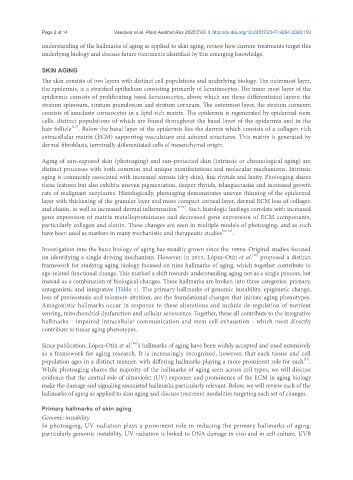Page 738 - Read Online
P. 738
Page 2 of 14 Vandiver et al. Plast Aesthet Res 2020;7:63 I http://dx.doi.org/10.20517/2347-9264.2020.159
understanding of the hallmarks of aging as applied to skin aging, review how current treatments target this
underlying biology and discuss future treatments identified by this emerging knowledge.
SKIN AGING
The skin consists of two layers with distinct cell populations and underlying biology. The outermost layer,
the epidermis, is a stratified epithelium consisting primarily of keratinocytes. The inner most layer of the
epidermis consists of proliferating basal keratinocytes, above which are three differentiated layers: the
stratum spinosum, stratum granulosum and stratum corneum. The outermost layer, the stratum corneum
consists of anucleate corneocytes in a lipid-rich matrix. The epidermis is regenerated by epidermal stem
cells, distinct populations of which are found throughout the basal layer of the epidermis and in the
[6,7]
hair follicle . Below the basal layer of the epidermis lies the dermis which consists of a collagen-rich
extracellular matrix (ECM) supporting vasculature and adnexal structures. This matrix is generated by
dermal fibroblasts, terminally differentiated cells of mesenchymal origin.
Aging of sun-exposed skin (photoaging) and sun-protected skin (intrinsic or chronological aging) are
distinct processes with both common and unique manifestations and molecular mechanisms. Intrinsic
aging is commonly associated with increased xerosis (dry skin), fine rhytids and laxity. Photoaging shares
these features but also exhibits uneven pigmentation, deeper rhytids, telangiectasias and increased growth
rate of malignant neoplasms. Histologically, photoaging demonstrates uneven thinning of the epidermal
layer with thickening of the granular layer and more compact corneal layer, dermal ECM loss of collagen
and elastin, as well as increased dermal inflammation [8-11] . Such histologic findings correlate with increased
gene expression of matrix metalloproteinases and decreased gene expression of ECM components,
particularly collagen and elastin. These changes are seen in multiple models of photoaging, and as such
have been used as markers in many mechanistic and therapeutic studies [12-15] .
Investigation into the basic biology of aging has steadily grown since the 1980s. Original studies focused
[16]
on identifying a single driving mechanism. However, in 2013, López-Otín et al. proposed a distinct
framework for studying aging biology focused on nine hallmarks of aging, which together contribute to
age-related functional change. This marked a shift towards understanding aging not as a single process, but
instead as a combination of biological changes. These hallmarks are broken into three categories: primary,
antagonistic and integrative [Table 1]. The primary hallmarks of genomic instability, epigenetic change,
loss of proteostasis and telomere attrition, are the foundational changes that initiate aging phenotypes.
Antagonistic hallmarks occur in response to these alterations and include de-regulation of nutrient
sensing, mitochondrial dysfunction and cellular senescence. Together, these all contribute to the integrative
hallmarks - impaired intracellular communication and stem cell exhaustion - which most directly
contribute to tissue aging phenotypes.
[16]
Since publication, López-Otín et al. ’s hallmarks of aging have been widely accepted and used extensively
as a framework for aging research. It is increasingly recognized, however, that each tissue and cell
[17]
population ages in a distinct manner, with differing hallmarks playing a more prominent role for each .
While photoaging shares the majority of the hallmarks of aging seen across cell types, we will discuss
evidence that the central role of ultraviolet (UV) exposure and prominence of the ECM in aging biology
make the damage and signaling associated hallmarks particularly relevant. Below, we will review each of the
hallmarks of aging as applied to skin aging and discuss treatment modalities targeting each set of changes.
Primary hallmarks of skin aging
Genomic instability
In photoaging, UV radiation plays a prominent role in inducing the primary hallmarks of aging,
particularly genomic instability. UV radiation is linked to DNA damage in vivo and in cell culture. UVB

